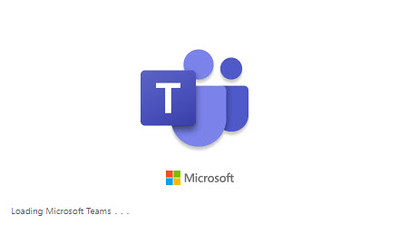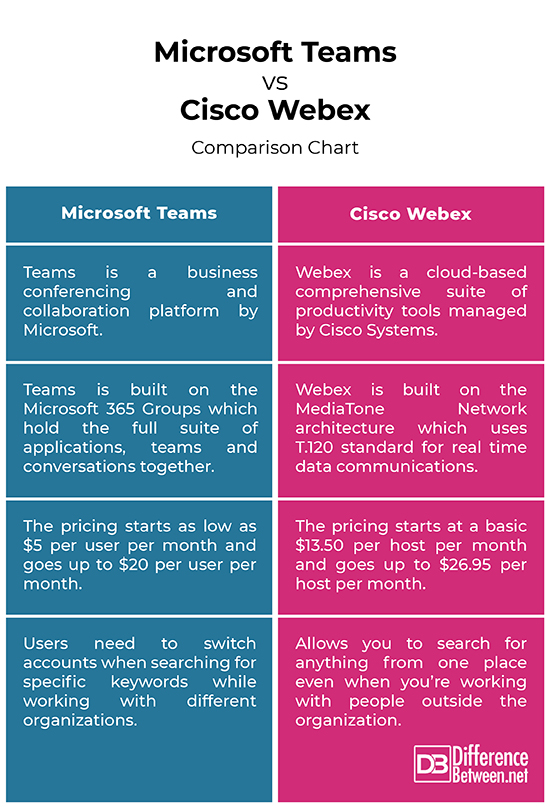Difference Between Teams and Webex
The 21st century workplace is unlike the traditional workplace where team collaboration could be confined to office spaces. The modern workplace is progressively transitioning into a space where collaboration and synchronicity are central, and team collaboration expands beyond traditional work hours and office spaces. So, the 21st century workspace requires an asynchronous platform that gives workers the ability to communicate and collaborate. The culture of working and the workplace setting has undergone some dramatic social and technological changes over the past couple of years. But, the true potential of corporate communication via online meetings and collaboration was only realized in the wake of the current Covid-19 pandemic which has shattered economies and forced major mindsets in adopting a virtual collaborative solution. We take a look at two such modern workplace collaboration and communication solutions – Microsoft Teams and Cisco Webex.

What is Microsoft Teams?
Team is a Microsoft’s proprietary web conferencing and collaboration platform that enables you to call, chat, meet and collaborate with others in real time without being physically present at the same location. Teams is a central hub of communication that brings conversations, meetings, files, and applications into a single, easy to use tool. Teams are a collection of individuals, content and tools associated with different projects and outcomes within an organization. It is a part of the Microsoft 365 family of products and an all-in-one collaborative platform that offers everything a team needs – online meetings, group conversations, audio/video conferencing, file sharing, and more. Teams is soon to be replacing the already popular Skype for Business and is already in the process of becoming a fully-integrated, all-in-one business communication platform.

What is Cisco Webex?
Webex is yet another popular online conference platform that provides similar functionalities as Teams, allowing people to meet and collaborate virtually over the Internet without having the need to leave your home or office. Cisco Webex is a cloud-based comprehensive suite of productivity tools and Web based meeting applications designed to improve workplace collaboration and increase productivity. It was originally founded by WebEx in 1995 and later taken over by the American technology giant Cisco Systems. Webex is a cost-effective communication and collaboration service that offers flexible customization options coupled with some great features designed to increase workplace communication and workflow. With its competitive pricing structure and a host of Web meeting applications, Webex is revolutionizing the idea of audio/video/web conferencing by providing a single unified interface.
Difference between Teams and Webex
Basics of Teams and Webex
– Teams is a Microsoft’s very own web conferencing and collaboration platform that brings the capabilities and functionalities of its peer Skype for Business and adds some of its own to create a fully-integrated, collaboration solution. Teams is part of the broader Microsoft 365 productivity suite that offers everything a team needs. Webex is yet another popular online conference platform that provides similar functionalities as Teams, but with a legacy hardware focus. Originally founded by WebEx in 1995, Webex is a cloud-based comprehensive suite of productivity tools and Web based meeting applications.
Architecture of Teams and Webex
– Teams is built on the Microsoft 365 Groups which hold the full suite of applications, teams and conversations together. It leverages Azure Active Directory (Azure AD) to store identity information, and integrates with other services within Microsoft 365. Each time you create a team in Teams, a SharePoint Online site and an Exchange Online group mailbox is automatically created. Webex, on the other hand, is built on a worldwide network architecture called the MediaTone Network which uses the T.120 standard for real time, platform-independent data communications.
Pricing of Teams and Webex
– In terms of pricing, Microsoft Teams is a clear frontrunner for two reasons. One, Teams has a fairly robust free version which is absolutely free of cost with a fewer limitations on recorded meetings, scheduled meetings, and so on. Second, it has a budget-friendly Enterprise Plan that comes bundled with the Office 365 Suite, which costs $20 per user per month (annual). The pricing starts as low as $5 per user per month. Cisco Webex also offers a free trial version which is very limited in terms of features and the lowest you could get is with a Webex Meeting plan which starts at a basic $13.50 per host per month and goes up to $26.95 per host per month for the Business plan.
Microsoft Teams vs. Cisco Webex: Comparison Chart

Summary
While both Microsoft Teams and Cisco Webex are great business communication and collaboration platforms with similar capabilities and features, Teams is built on the Microsoft 365 Groups surrounding productivity and collaboration whereas Webex is an online meeting environment that is part of a larger Cisco suite of online collaboration tools. Teams is an all-in-one collaborative platform that offers everything a team needs and Webex is a comprehensive suite of productivity tools that keeps teams connected. So, they do have their fair share of pros and cons, but both of them revolve around the central idea of easy and seamless collaboration across different platforms from office desktops to smartphones on the road.
- Difference Between Caucus and Primary - June 18, 2024
- Difference Between PPO and POS - May 30, 2024
- Difference Between RFID and NFC - May 28, 2024
Search DifferenceBetween.net :
Leave a Response
References :
[0]Stevenson, Nancy. WebEx Web Meetings For Dummies. New Jersey, United States: John Wiley & Sons, 2005. Print
[1]Withee, Rosemarie. Microsoft Teams For Dummies. New Jersey, United States: John Wiley & Sons, 2020. Print
[2]Morgan, Brian, et al. Cisco Unified Presence Fundamentals. Indiana, United States: Cisco Press, 2010. Print
[3]Image credit: https://commons.wikimedia.org/wiki/File:WebEx_logo.svg
[4]Image credit: https://live.staticflickr.com/65535/49836545517_f64518b5d6_w.jpg
